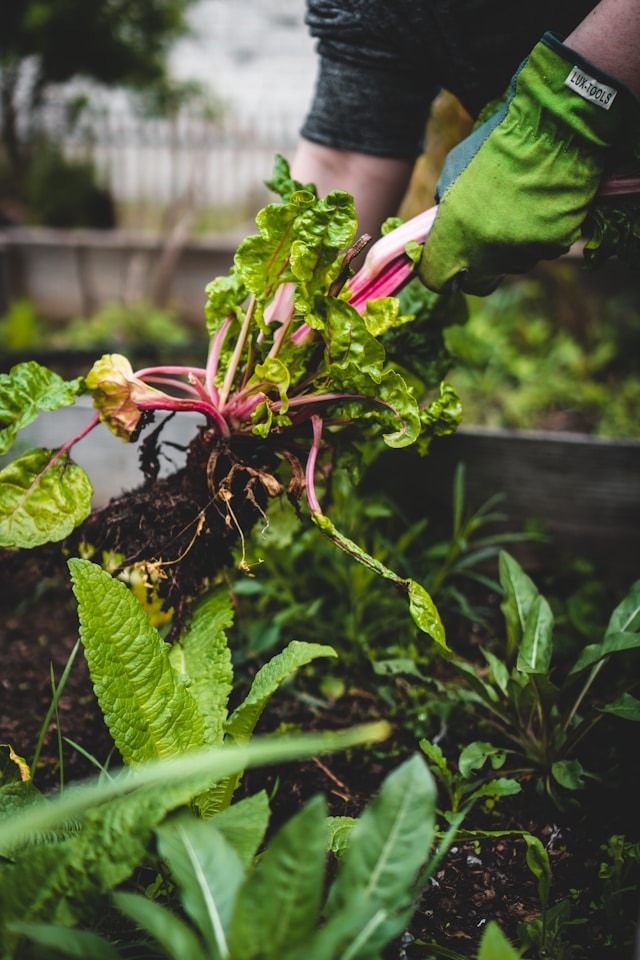Growing Rhubarb is quite possibly one of the easiest things in the world to do.
It is a very forgiving plant and extremely hardy, handling most cold winters easily. It’s perennial and will last you for years. It’s not that fussy about the type of ground you grow it in either, as long as it has full sun and is kept moist in the summer it’s happy and will give you an abundant crop year-on-year. That said, if you do have particularly bad soil, then growing them in raised mounds of good quality compost above the poor soil will be beneficial.
Of course, Rhubarb is also a large spreading plant so growing rhubarb in containers is not really a viable option. Some have tried, but reported that the plants did not like the environment they were in and failed to thrive.
Hence I have placed growing Rhubarb on my “unsuitable for containers” list.
Nevertheless, if you do have a spare sunny bit of garden where you can grow it, then growing rhubarb is well worth it, and you will enjoy a great tasting crop for most of the year, with very little effort in your part.
Growing
You can grow rhubarb from seed, although some prefer to buy sprouting crowns that have been taken from established rhubarb plants. It doesn’t matter which method you opt for, both are as easy to grow as each other.
Start your seeds off in January under cover. An indoor windowsill or greenhouse is fine. Just sprinkle the seeds over a pot of potting compost, then sprinkle another 1cm of compost over the seeds and water lightly, then just keep the soil slightly moist and do not allow it to dry out as the seedlings come up.
By the time the last frost has taken place you should have some great looking young plants to transplant. Harden them off over a week or so, by placing them outside during the day, then divide them up and plant them into the ground in their permanent positions. Place the young plants between 50 and 80cm apart as singles or as small clumps of 2 or 3.
Forcing
You can get a head start on established rhubarb plants, and encourage them to grow faster by doing something known as ‘forcing’. At the start of the year in late winter / early spring, you simply isolate the new growth from the light by placing a large container up-side-down over the plant. This will cause them to grow fast and tall. Leave the cover on for about 4-6 weeks and you will be able to start harvesting shortly afterwards. This should not be done in the first year with new plants, only established ones.
Dividing
Rhubarb plants grow strongly and rapidly, and soon they may out-grow the garden area you have provided for them. When this happens you can divide a rhubarb plant up at its root, and replant the off-cuts elsewhere, or give them away. They will grow just as well. To divide a root and transplant it, wait until autumn or winter after you have finished harvesting from it for that year. Trim back the greenery down to just stems, then using a spade, split the root up ensuring there are buds or stems on each of the divisions. Some established gardeners say you should leave the crown out of the ground for at least one frost before re-planting it.When re-planting the divided roots segments back into the ground, allow the green stems or buds to remain exposed to the light, and firm-in in the rest of the root to hold it in place.
Pruning
At the end of the growing season, the rhubarb will begin to wilt away and go brown. Cut back any remaining foliage and it will grow back the following spring in abundance again.
Harvesting
Important: Only eat the stems of the plant i.e. the bit between the ground and the leaves. The actual leaves themselves are poisonous (they contain oxalic acid)!
When the Rhubarb is ready to harvest, pull the stem away from the plant (do not cut) and cut away the leaves.
Some say it’s best not to harvest from your plant in the first year to provide a stronger plant the following year. I would say take a few but not all of the stalks in the first year.
Rhubarb is great for deserts, pies, and as an accompaniment to also game meat such as venison and duck.

